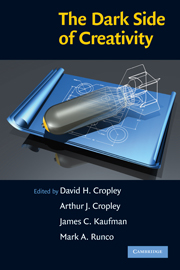Book contents
- Frontmatter
- Contents
- List of Contributors
- 1 The Dark Side of Creativity: What Is It?
- 2 Creativity Has No Dark Side
- 3 Positive Creativity and Negative Creativity (and Unintended Consequences)
- 4 Subjugating the Creative Mind: The Soviet Biological Weapons Program and the Role of the State
- 5 Imagining the Bomb: Robert Oppenheimer, Nuclear Weapons, and the Assimilation of Technological Innovation
- 6 The Innovation Dilemma: Some Risks of Creativity in Strategic Agency
- 7 Early Creativity as a Constraint on Future Achievement
- 8 Boundless Creativity
- 9 Reviewing the Art of Crime: What, If Anything, Do Criminals and Artists/Designers Have in Common?
- 10 Creativity in Confinement
- 11 Creativity and Crime: How Criminals Use Creativity to Succeed
- 12 So You Want to Become a Creative Genius? You Must Be Crazy!
- 13 Both Sides of the Coin? Personality, Deviance, and Creative Behavior
- 14 Neurosis: The Dark Side of Emotional Creativity
- 15 Dangling from a Tassel on the Fabric of Socially Constructed Reality: Reflections on the Creative Writing Process
- 16 Creativity in the Classroom: The Dark Side
- 17 The Dark Side of Creativity and How to Combat It
- 18 A Systems Engineering Approach to Counterterrorism
- 19 Malevolent Innovation: Opposing the Dark Side of Creativity
- 20 Summary – The Dark Side of Creativity: A Differentiated Model
- Index
- References
12 - So You Want to Become a Creative Genius? You Must Be Crazy!
Published online by Cambridge University Press: 05 June 2012
- Frontmatter
- Contents
- List of Contributors
- 1 The Dark Side of Creativity: What Is It?
- 2 Creativity Has No Dark Side
- 3 Positive Creativity and Negative Creativity (and Unintended Consequences)
- 4 Subjugating the Creative Mind: The Soviet Biological Weapons Program and the Role of the State
- 5 Imagining the Bomb: Robert Oppenheimer, Nuclear Weapons, and the Assimilation of Technological Innovation
- 6 The Innovation Dilemma: Some Risks of Creativity in Strategic Agency
- 7 Early Creativity as a Constraint on Future Achievement
- 8 Boundless Creativity
- 9 Reviewing the Art of Crime: What, If Anything, Do Criminals and Artists/Designers Have in Common?
- 10 Creativity in Confinement
- 11 Creativity and Crime: How Criminals Use Creativity to Succeed
- 12 So You Want to Become a Creative Genius? You Must Be Crazy!
- 13 Both Sides of the Coin? Personality, Deviance, and Creative Behavior
- 14 Neurosis: The Dark Side of Emotional Creativity
- 15 Dangling from a Tassel on the Fabric of Socially Constructed Reality: Reflections on the Creative Writing Process
- 16 Creativity in the Classroom: The Dark Side
- 17 The Dark Side of Creativity and How to Combat It
- 18 A Systems Engineering Approach to Counterterrorism
- 19 Malevolent Innovation: Opposing the Dark Side of Creativity
- 20 Summary – The Dark Side of Creativity: A Differentiated Model
- Index
- References
Summary
Please allow me to begin this chapter with an autobiographical observation: I have been conducting scientific research on creativity and genius – and especially creative genius – since the early 1970s. During the first quarter century of my career, I was often hard pressed to justify my research program (Simonton, 2002). Although the subject had once attracted the attention of such great psychologists as Francis Galton, James McKeen Cattell, Lewis M. Terman, and Edward L. Thorndike, the topic had become marginalized relative to mainstream research in psychology. Toward the end of the twentieth century, though, an unexpected event altered the status of my endeavors: the positive psychology movement. Martin Seligman, Mihaly Csikszentmihalyi, and others argued that it was time for psychologists to study human strengths and virtues rather than human weaknesses and vices (for instance, Seligman & Csikszentmihalyi, 2000). Besides suggesting new topics for psychological inquiry, the proponents of positive psychology also decided to co-opt already ongoing investigations as representative of the movement. Somewhat to my surprise, creativity, genius, and creative genius were added to the growing inventory of representative subjects for positive psychological studies. As a result, I began to receive invitations to give talks at positive psychology conferences and to write chapters for handbooks and anthologies devoted to the emerging field (for instance, Cassandro & Simonton, 2002).
Now I probably should not complain about seeing my life's work get enhanced attention. And I certainly relished the free trips to conferences and the additional publications in my curriculum vitae.
- Type
- Chapter
- Information
- The Dark Side of Creativity , pp. 218 - 234Publisher: Cambridge University PressPrint publication year: 2010
References
- 20
- Cited by



